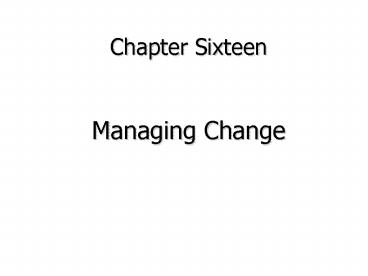Chapter Sixteen - PowerPoint PPT Presentation
1 / 19
Title:
Chapter Sixteen
Description:
turnover are signs that change is needed. Managerial Behavior/Decisions ... Decide they can develop a compatible working relationship. Contracting ... – PowerPoint PPT presentation
Number of Views:42
Avg rating:3.0/5.0
Title: Chapter Sixteen
1
Chapter Sixteen Managing Change
2
Forces of Change
External Forces originate outside the
organization.
- Demographic Characteristics- the workforce is
more diverse- there is a business imperative to
effectively manage diversity - Technological Advancements- organizations are
increasingly using technology as a means to
improve productivity and market competitiveness - Market Changes- the emergence of a global
economy is forcing companies to be more
competitive and to do business differently-
organizations are forging new partnerships and
alliances aimed at creating new products and
services - Social and Political Pressures- society and its
legislative bodies can put pressure on
organizations to change the way they do business
the tobacco industry is a good example
3
Forces of Change (continued)
Internal Forces originate inside the
organization.
- Human Resource Problems/Prospects- employees
needs, job satisfaction, organizational
commitment, behavior, and performance are forces
of change- dissatisfied employees and high
levels of absenteeism and turnover are signs
that change is needed - Managerial Behavior/Decisions- the level of
conflict between managers and their direct
reports is a force for change- inappropriate
leader behavior may result in employee problems
requiring change- inequitable reward systems are
an additional force for change
4
Lewin's Three Step Model
Unfreezing
Refreezing
Movement or Change
5
A Systems Model of Change
Target Elements of Change
OrganizingArrangements
Inputs
Outputs
Internal Strengths Weaknesses External
Opportunities Threats
OrganizationalLevel Department/group
level Individuallevel
Strategy
Goals
Social Factors
People
Methods
6
Kotters Steps for Leading Organizational Change
- Step Description
- Establish a sense Unfreeze the organization by
creating aof urgency compelling reason for why
change is needed. - Create the guiding Create a cross-functional,
cross-level group ofcoalition people with
enough power to lead the change. - Develop a vision Create a vision and strategic
plan to guide theand strategy change process. - Communicate the Create and implement a
communication strategychange vision that
consistently communicates the new vision and
strategic plan. - Empower broad- Eliminate barriers to change, and
use targetbased action elements of change to
transform the organization. Encourage risk
taking and creative problem-solving.
7
Kotters Steps for Leading Organizational Change
(continued)
- Step Description
- Generate short- Plan for and create short-term
wins orterm wins improvements. Recognize and
reward people who contribute to the wins. - Consolidate gains The guiding coalition uses
credibility fromand produce more short-term wins
to create more change.change Additional people
are brought into the change process as change
cascades throughout the organization.
Attempts are made to reinvigorate the change
process. - Anchor new Reinforce the changes by
highlightingapproaches in the connections
between new behaviors and culture processes and
organizational success. Develop methods to
ensure leadership development and successes.
8
Resistance To Change
Resistance to Change an emotional/behavioral
response to real or imagined work change.
For Class Discussion What do you think are the
top three reasons people resist change? How do
we overcome the resistance to change?
9
Characteristics of OrganizationDevelopment (OD)
- OD involves profound change
- OD is value loaded
- OD is a diagnosis/prescription cycle
- OD is process-oriented
10
Phases of Organizational Development
- Organizational development unfolds in a series of
phases - Entry, Contracting, Diagnosis, Feedback,
Planning, Intervention, Evaluation, Termination - These are phases, not steps, because no clear
boundaries exist between them - Phases can repeat.
11
Entry
- First contact of the consultant with the client
- Usually client initiates contact
- Building a client-consultant relationship
- Mutual evaluation of each other
- Decide they can develop a compatible working
relationship
12
Contracting
- Develop an agreement between the consultant and
client - Can range from an oral agreement to a legally
binding agreement - Describes mutual expectations and each partys
duties - Not static. Subject to renegotiation as the
organizational development program unfolds
13
Diagnosis
- Consultant gets information about the client
system and diagnoses its current state - Observe the clients behavior and reactions
- Observe physical characteristics of system
- Systematic data collection using surveys,
interviews, and company records - Consultant summarizes this phases results for
feedback to the client system
14
Feedback
- Consultant has a series of feedback meetings with
client system members - The number of meetings varies according to the
scope of the organizational development program - Several steps
- Consultants analysis
- Discussion
- Consultants preliminary diagnosis
- Actively work with members of client system to
arrive at collaborative diagnosis
15
Planning
- Collaborative activity between consultant and
client system - Identify alternative courses of action and the
effects of each - Lay out the steps in the change program
- Client decides the nature of the change
programnot the consultant
16
Intervention
- Collaborative intervention to move the client
system to the desired future state - Includes job and organizational design changes,
conflict reduction program, and the like. - Consultants role
- Earlier client involvement helps reduce
resistance to change in the intervention phase
17
Evaluation
- Focuses on whether the organizational development
effort had the desired effect - Ranges from simply asking how the client feels to
a well-designed research effort - Done independently of the consultant
- Should also give the client system information
about the next steps to take
18
Termination
- Ends at some point
- Internal consultants are part of the organization
and can continue contact - The goal is independence of the client system
from the consultant. Build client system
self-reliance
19
Interventions
- Human Process
- Goal improve human processes to get more
effective organizational functioning - Structural and technological
- Goal improve human productivity and
organizational effectiveness - Human resource management
- Goal change individual behavior and performance
to get improved organizational effectiveness - Strategy
- Goal strategic shifts to gain competitive
advantage































